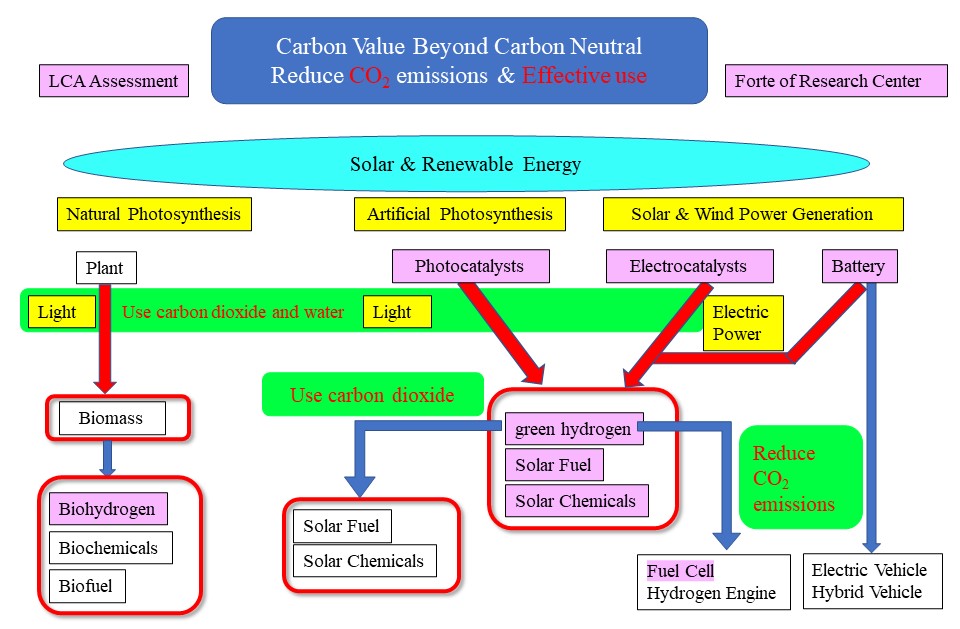CVRC Mission
Items to be considered and strengths at the site (purple area)

Many efforts are underway around the world to become carbon neutral, a concept that would reduce carbon emissions to virtually zero. The use of renewable energy is a prerequisite for achieving carbon neutrality. This will help solve the resource, energy, and environmental problems that humanity faces. When it comes to renewable energy use, most people think of solar power and wind power. Looking back at our daily lives, not only electrical energy but also materials such as fuels (chemical energy) and chemical products are indispensable. To synthesize these substances, hydrogen (H) and carbon (C) are needed as the main raw materials. Here, to achieve carbon neutrality, water(H2O) must be used as the hydrogen source and carbon dioxide(CO2) as the carbon source. This means that carbon dioxide must be used as a carbon source to synthesize high-value substances such as gasoline, jet fuel, olefins, and alcohols (this is called "Carbon Value").
To convert carbon dioxide into a resource, it is essential to develop science and technology to reduce carbon dioxide (reacting it with electrons or hydrogen) using renewable energy sources such as sunlight. Direct carbon dioxide reduction methods include photochemical and electrochemical methods. Here, light must be solar and electricity must be electricity generated from renewable energy sources (renewable electricity). Another indirect method is the thermocatalytic reduction of carbon dioxide using solar hydrogen (green hydrogen) produced from water using renewable energy. On the other hand, to use renewable electricity, a battery is needed to store it. For this reason, the development of lithium and sodium ion batteries is also an important topic worldwide. Battery technology is not limited to electrolytic synthesis, but can contribute to carbon neutrality through its use in electric vehicles and other applications.
Hydrogen is also an essential substance for carbon neutrality. You would think that hydrogen is a clean energy source that fuels fuel cells. Therefore, it must also be linked to fuel cell technology. In addition to this, hydrogen is also essential as a key substance in the chemical industry. Many chemical products are produced chemically using hydrogen as a raw material. One of the most important of these is ammonia, which is used in chemical fertilizers. If hydrogen cannot be produced due to depletion of fossil resources, chemical fertilizers cannot be made. This will be a critical issue for humanity. Thus, hydrogen is not only a clean energy source, but is indispensable to support the materials of today's society. In other words, it is no exaggeration to say that anything is possible with hydrogen. The industrial hydrogen production method in modern society is steam reforming, in which fossil resources such as oil, natural gas, and coal are reacted with water at high temperatures. However, this hydrogen production method still has the problems of fossil fuel depletion and carbon dioxide emissions. Running fuel cell vehicles on hydrogen obtained in this way is not a fundamental solution to environmental problems. Therefore, it is desirable to develop a technology to produce hydrogen from water using renewable energy. One such science and technology is artificial photosynthesis, which uses photocatalysis to decomposition of water to produce hydrogen.
The objective of this research center is to develop science and technology to effectively utilize and reduce excess carbon dioxide emissions by converting carbon dioxide, which is an important carbon resource, into valuable substances. Furthermore, we will develop science and technology that will be carbon negative. A typical example of this science and technology is the production of hydrogen through water splitting using renewable energy. Research will focus on the development of photocatalysts, electrocatalysts, and rechargeable batteries necessary for these scientific processes. In addition, we will conduct research and development of fuel cells and bio-hydrogen. We will also proceed with life cycle assessment (LCA: a method for quantitatively evaluating the environmental impact of a product or service over its entire life cycle (resource extraction - raw material production - product production - distribution and consumption - disposal and recycling) at the same time.
pagetop